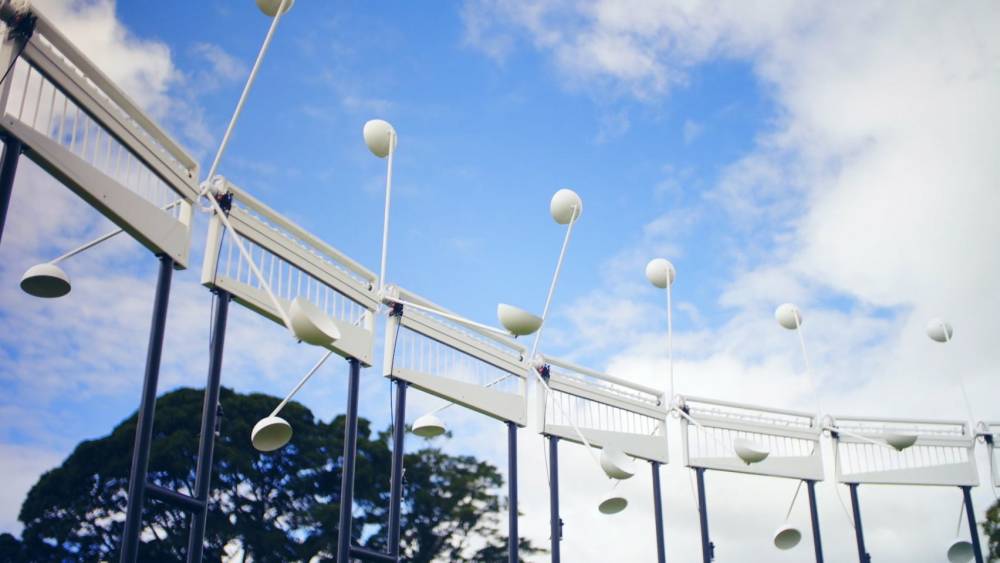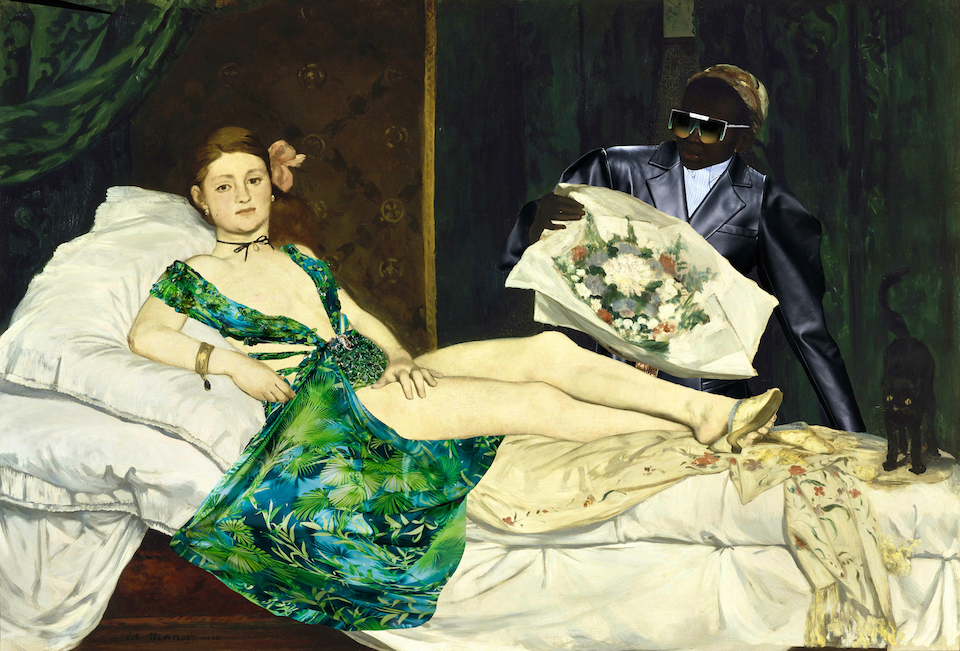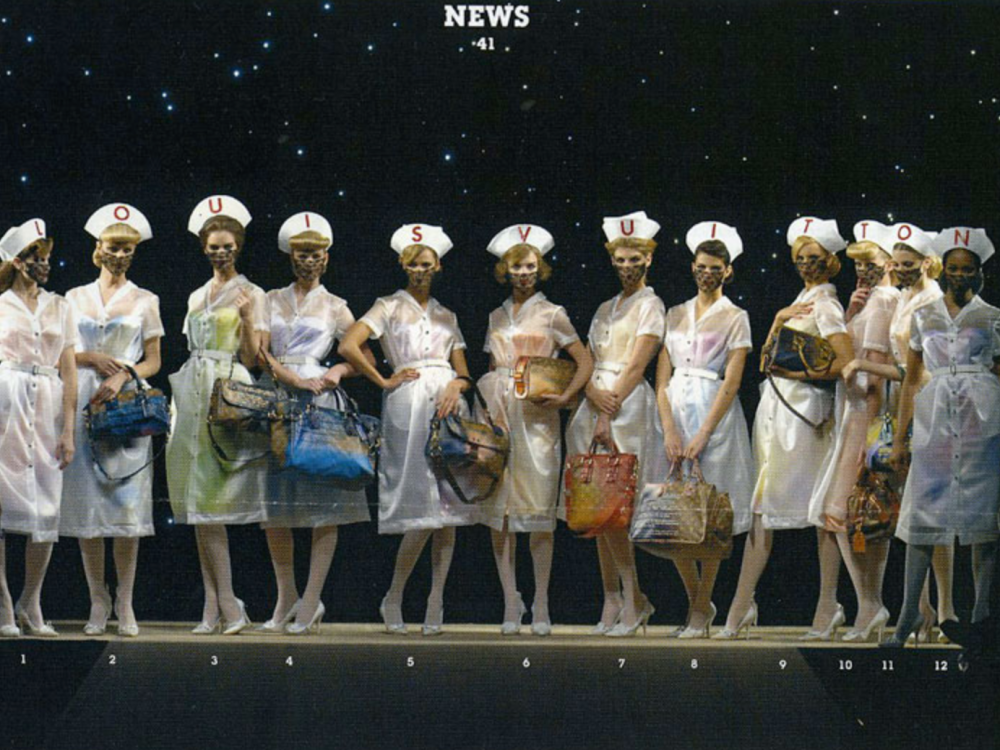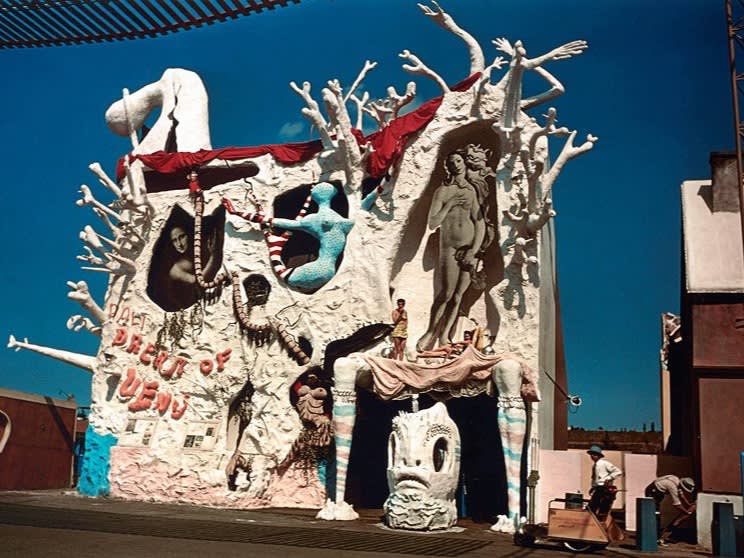
James Dean and Elizabeth Taylor
On set of “Giant” 1956
As early as Ancient Rome, horses have been an important symbolic figure in statues and portraiture. The Roman Equestrian Statue of Marcus Aurelius, finished in 175 A.D., has become a template for future artists’ renderings of esteemed leaders, monarchs, and military victors. Through posing of the horse and figure, artists throughout the centuries have idolized men as heroic and chivalrous symbols of strength for their nation.
Drawing from the statue of Marcus Aurelius, 16th century artist Titian depicted Charles V on horseback. Sitting strong atop a charging horse, the subject wears bright metallic armor, posed for victory. The painting draws comparison to the warriors of Ancient Rome, looking back to antiquity, as many artists did during the Renaissance, as a symbol of discipline and military strength. Almost a century later in 1637, the Flemish court painter Anthony Van Dyck depicted the English king Charles I on horseback. Furthering the work of his predecessors, Van Dyck painted in levels of resolution with a faded background and clear bold depiction of the figure on horseback, further emphasizing the nobility and heroism of the king. These early works set the stage for equestrian themes throughout art, as future artists would further develop on the symbolism of the horse and, more recently, use art to subvert the symbol to suit the artist’s own interpretation.
Theodore Gericault’s “The Charging Chasseur,” painted in 1812, both utilizes and rejects the template put in place by classical art. A Napoleonic cavalry officer is depicted on horseback as with the works of Titian and Van Dyck. Unlike these classical models, however, Gericault’s painting utilizes dramatic diagonals, contorting the rider into an unnatural pose. The mood of the portrait signals retreat rather than victory, contradicting the theme of the equestrian rider as divine and heroic. The work has drawn even more attention in recent years since being featured at the Louvre in Beyoncé and Jay-Z’s “Apeshit” music video.
Roman
Equestrian Statue of Marcus Aurelius, 175 A.D.
Titian
Equestrian Portrait of Charles V, 1548
Anthony van Dyck
Equestrian Portrait of Charles I, 1637-38
Théodore Géricault
The Charging Chasseur, 1812
Another artist who skewed the idea of the equestrian portrait was Edgar Degas. Throughout his career, Degas painted over ninety works depicting racehorses, often inspired by the Longchamp racetrack in Paris. Degas’ paintings focus on the blurred movement of the horses and riders rather than the stationary poses of the classical works. Contemporary artist Richard Prince built his career on appropriation, so it’s no surprise that his “Untitled (Cowboy)” series would appropriate not only magazine advertisements but also equestrian portraiture. Blurring, cropping, and enlarging images from Marlboro cigarette ads, Prince echoes Van Dyck’s work by drawing attention to or away from certain parts of the image. The artist’s 1990 series deconstructed the myth of the cowboy and the American West, as well as considering our fascination with fantasy and myth over reality.
The contemporary artist Mauricio Cattelan’s work takes the equestrian statues of ancient Rome and their Renaissance revival and contorts them into jarring images through the use of taxidermy and positioning. Cattelan’s horses are shown riderless, suspended in air or mounted headless to a wall. Cattelan’s work, like that of Richard Prince, examines the contradictions between history, religion, and reality. The once-heroic image of the horse is now shown desperate and isolated.
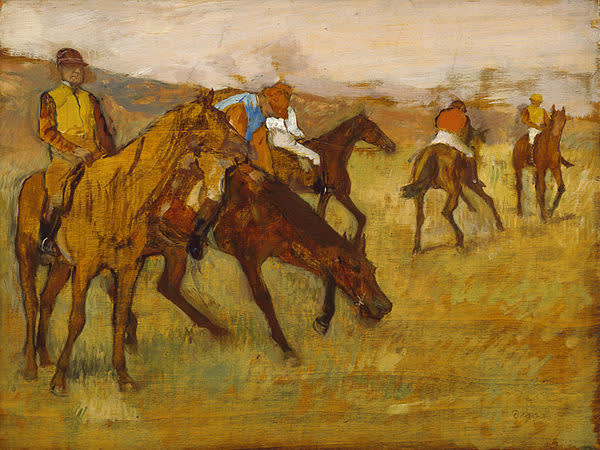
Edgar Degas
Before the Race, 1882-84
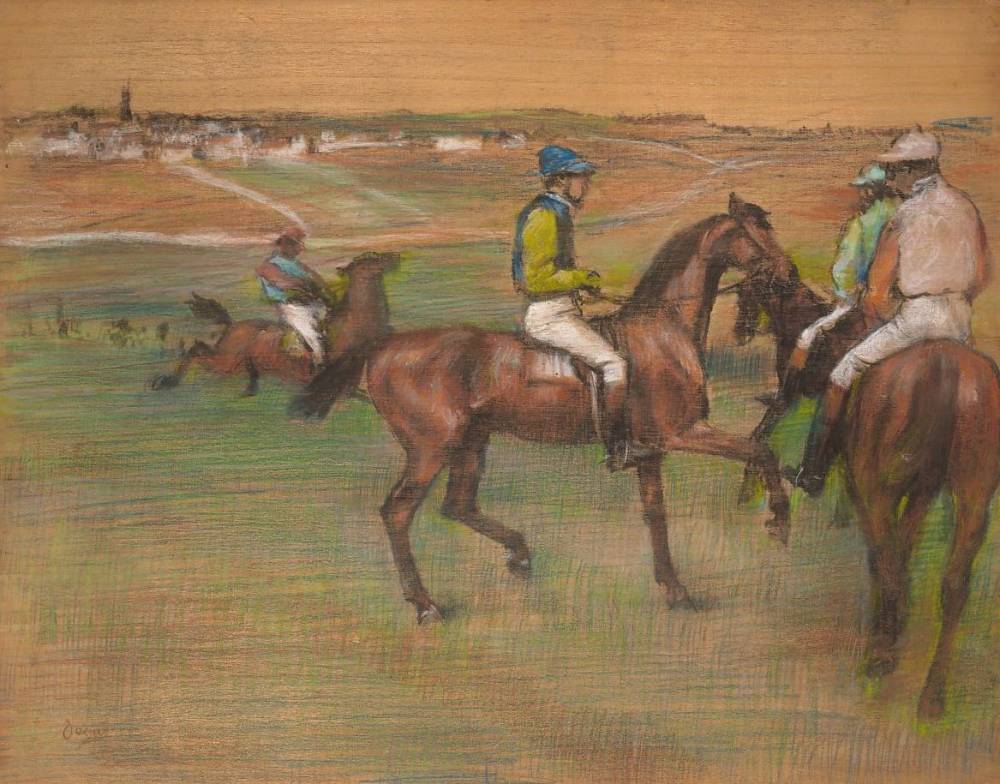
Edgar Degas
Race Horses, 1885-88
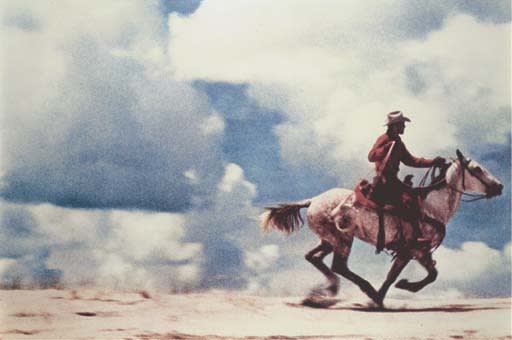
Richard Prince
Untitled (Cowboy), 1989
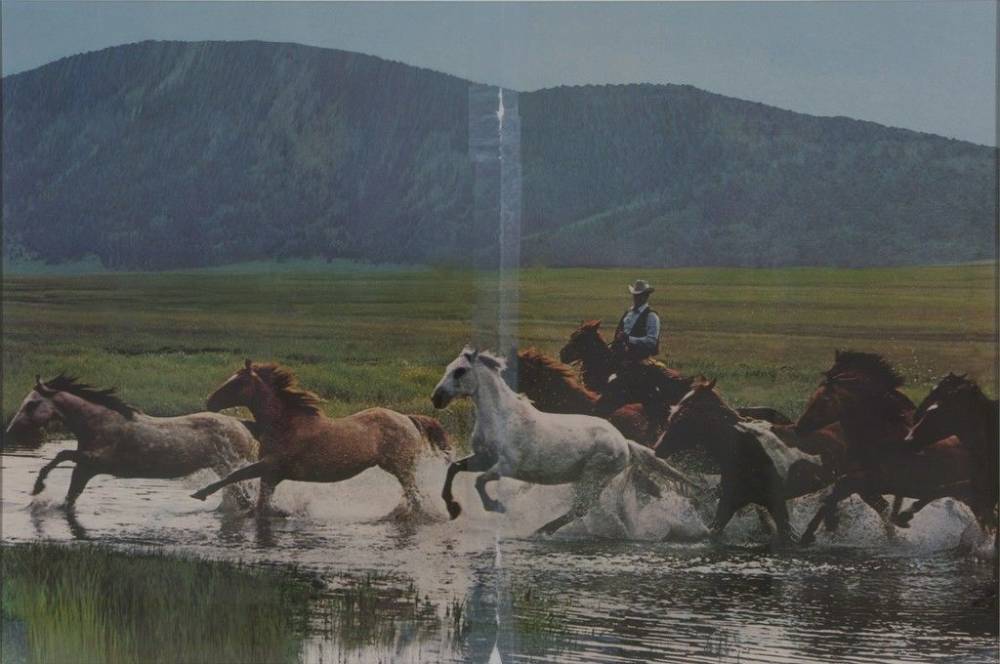
Richard Prince
Untitled (cowboy), 2016
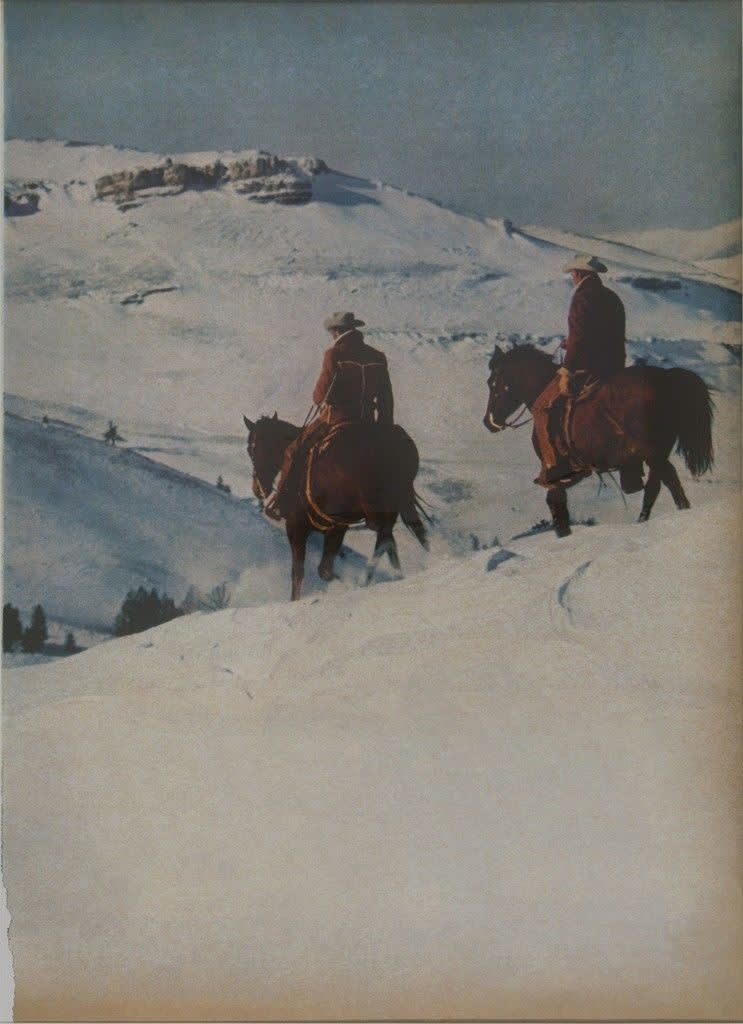
Richard Prince
Untitled (cowboy), 2016
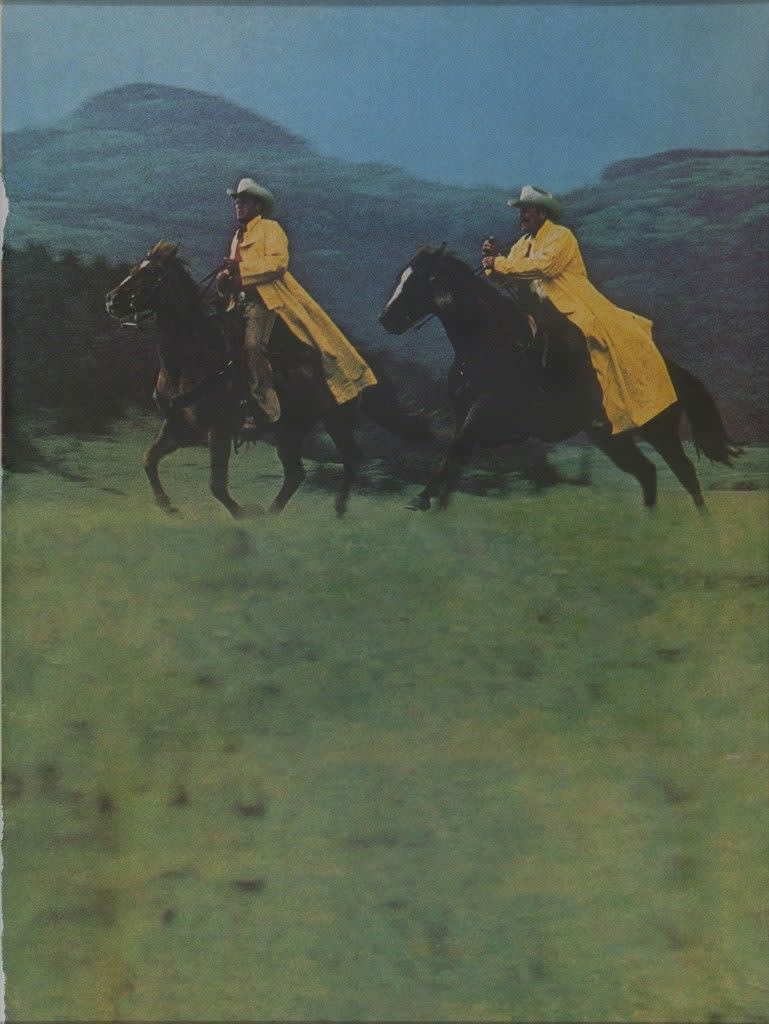
Richard Prince
Untitled (cowboy), 2016
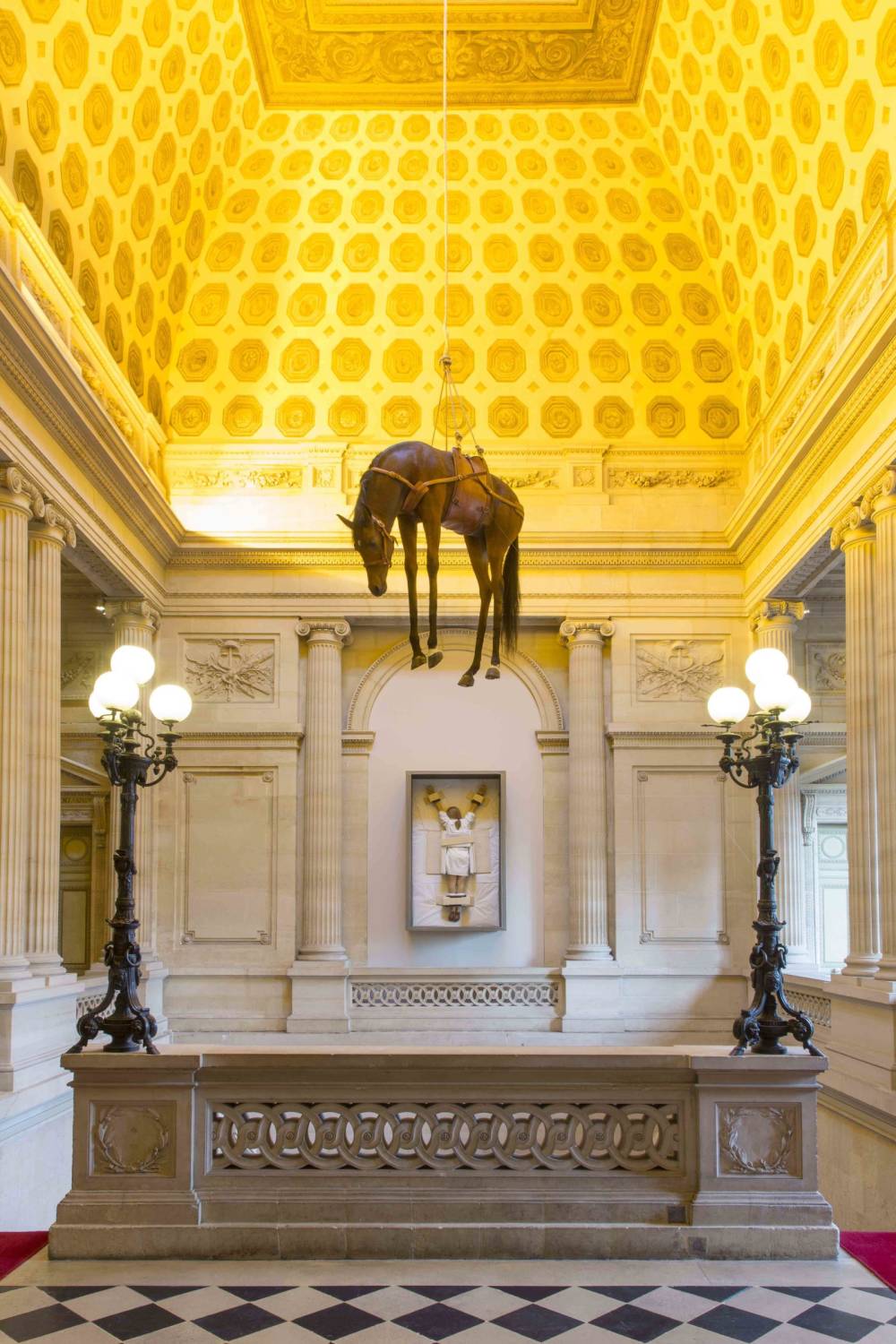
Maurizio Cattelan
Zeno Zotti, 1997
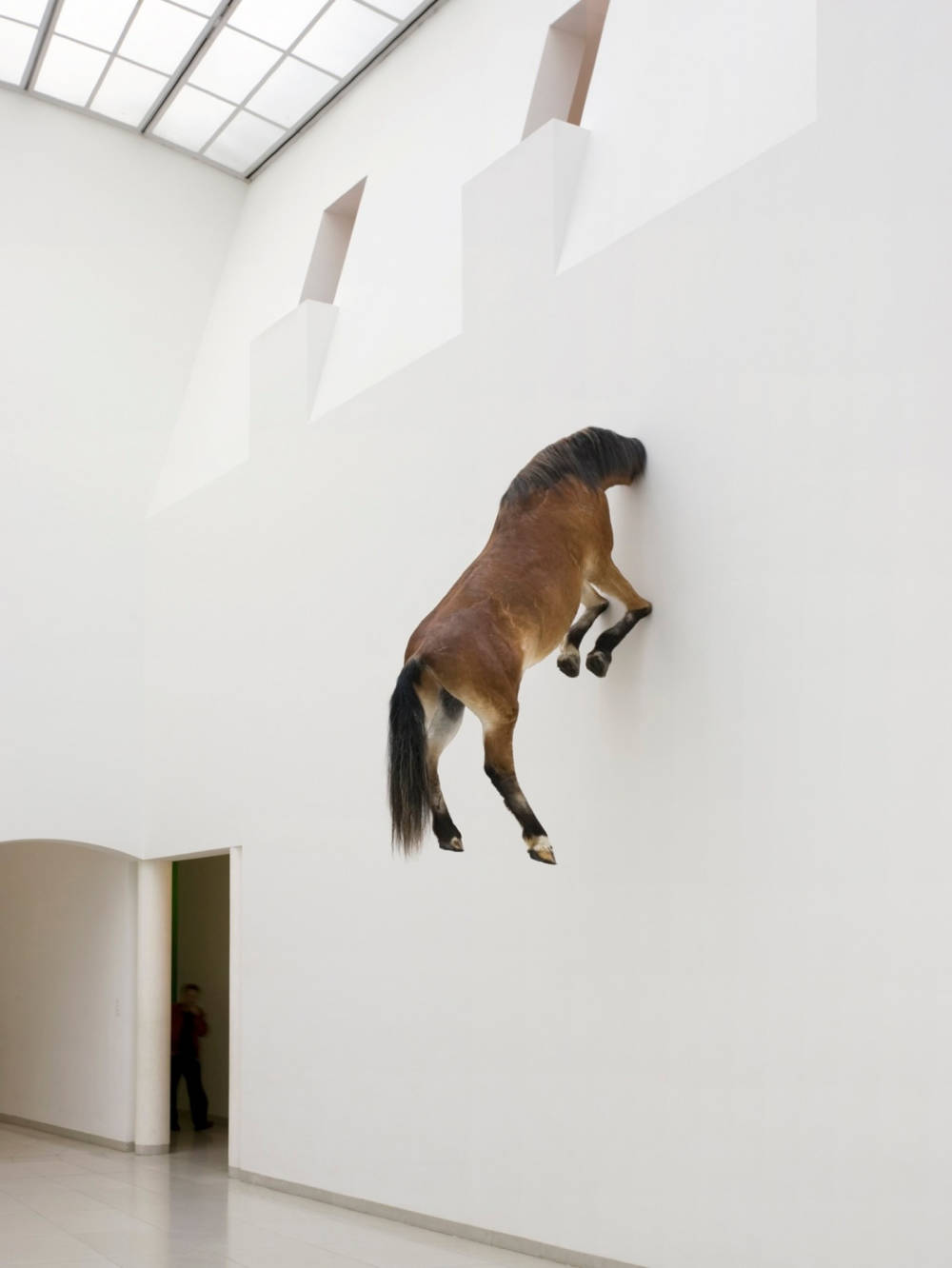
Maurizio Cattelan
Untitled, 2007
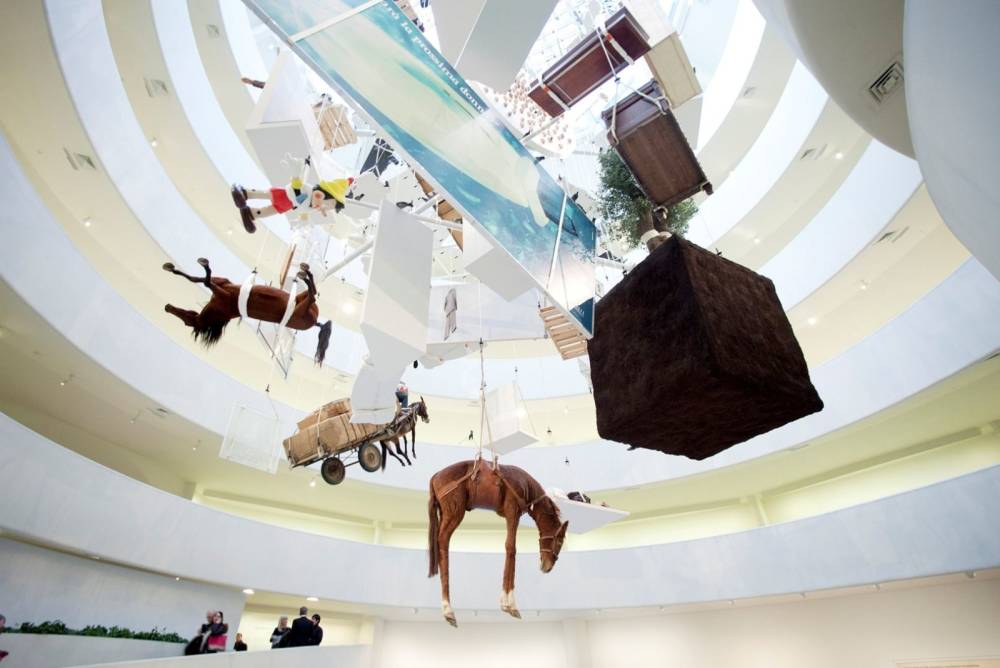
Maurizio Cattelan
Guggenheim Museum, New York, 2011-12
Other artists have focused their attention on the rocking horse. Rather than an animal representing victory or freedom, the rocking horse works more as a machine, representing domesticity and family life. Leonora Carrington’s 1937 self-portrait, the artist’s first truly surrealist work, examines the disparity between the horse and its childish replication. A floating rocking horse without a tail is juxtaposed with a galloping white horse seen outside of the window. In this “mental self-portrait,” Carrington represents herself through her own image as well as each of the animals within the painting. While the white horse symbolizes freedom, the rocking horse references Carrington’s play Pénélope, in which a girl falls in love with her toy rocking horse. These two images contradict freedom with the domestic aspects of the artist’s life. Similarly, Alice Neel’s 1943 portrait of her son, “Hartley on the Rocking Horse,” examines this balance. The artist is pictured in a mirror within the painting, suggesting her role as a mother. Meanwhile, the child’s pose on the rocking horse in the center of the image contrasts with his haunting expression, perhaps suggesting a disillusion with family life, hinting that more lurks beneath the surface. Siah Armajani’s 2004 work “Fallujah” uses the rocking horse as a symbol of domestic life in contrast with the horrors of war. Referencing Picasso’s work “Guernica,” which similarly examined the atrocities of war, Armajani’s installation depicts a house collapsing into flames as a response to a battle during the Iraq War.
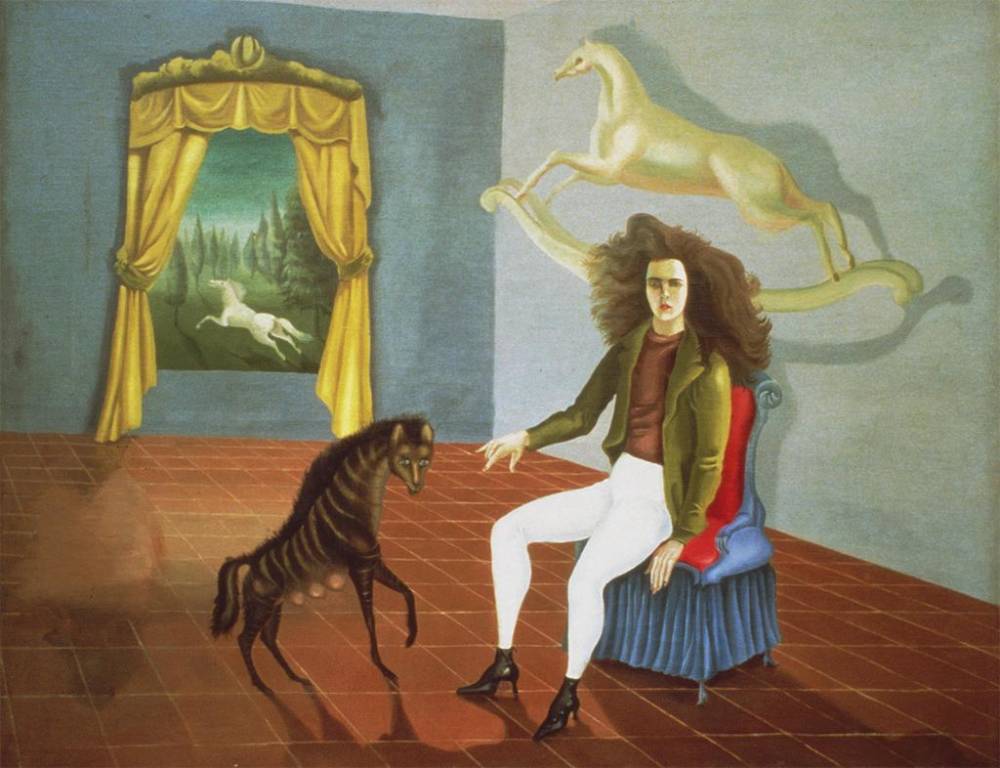
Leonora Carrington
Self Portrait, 1937-38
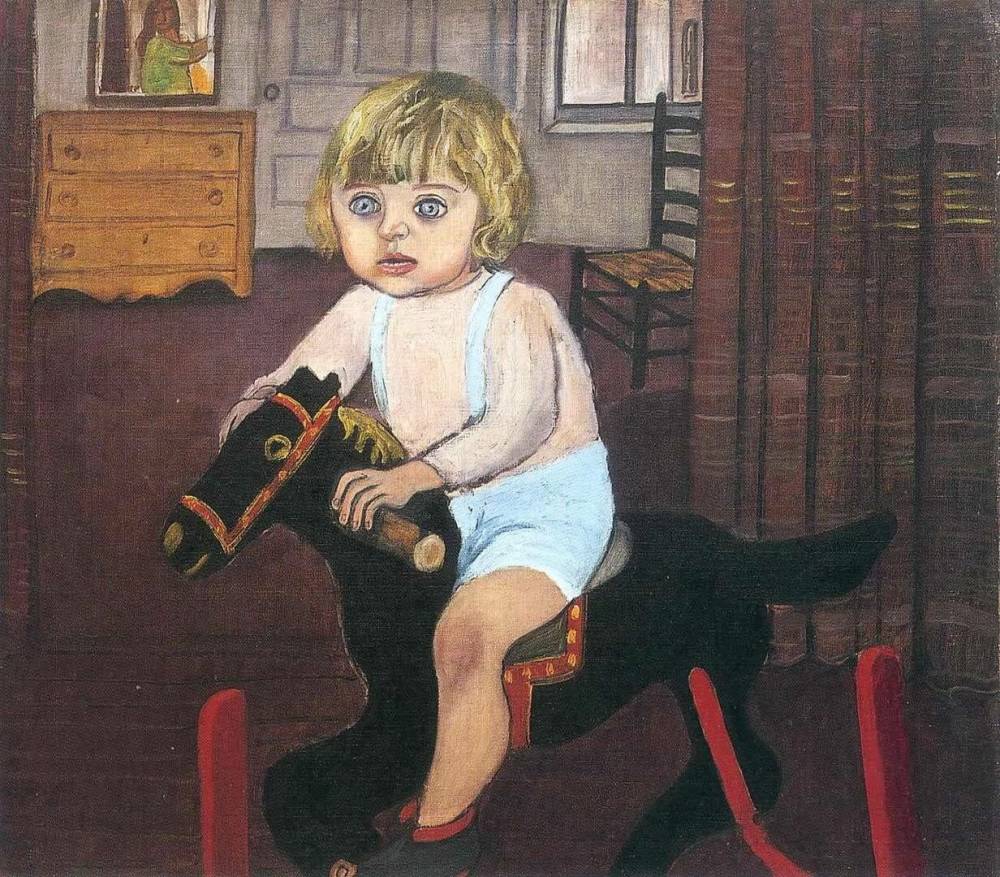
Alice Neel
Hartley on the Rocking Horse, 1943
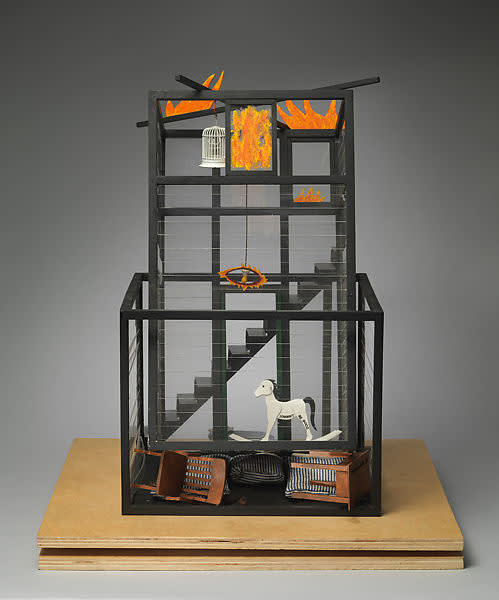
Siah Armajani
Fallujah, 2004
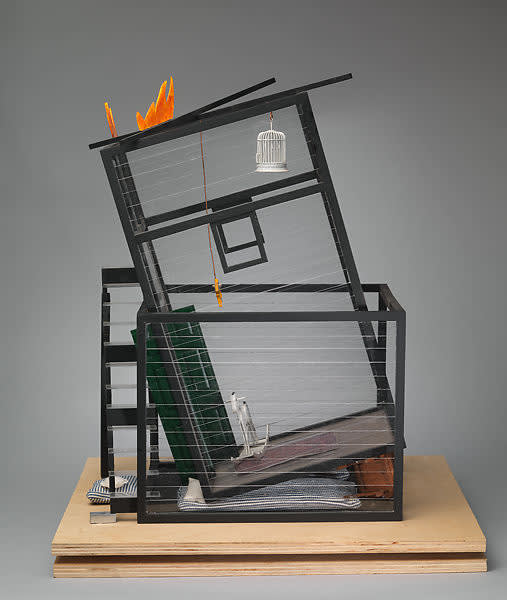
Siah Armajani
Fallujah, 2004
The fashion world deals with horses not only in symbolic terms but also in the physical manufacturing of sportswear and leather goods associated with riding. The French luxury house Hermes is one of the world’s most well-known producer of equestrian gear. Established in 1837, the house was originally a producer of harnesses and bridles for the carriage trade. When Hermes’ son, Charles-Emile took over in 1880, the company introduced saddles to its product line. The 1900 Haut a Courroies bag, designed for their elite clientele to carry their saddles with them, soon morphed into a smaller, more fashionable version in 1922. The bag gained popularity and Hermes began manufacturing leather handbags, eventually leading to the now-iconic Kelly and Birkin bags. To celebrate this heritage, creative director Jean-Paul Gaultier devoted the Spring/Summer 2011 show—his final collection for the house—to equestrian styles. Leather bustiers, trouser suits, jodhpurs, and riding boots saluted the history of Hermes.
Hermès
Advertisement, 1923
Hermès
Advertisement
Hermès
Advertisement, 1950s
Hermès
Kelly Bag Advertisement, 1983
Hermès
Advertisement, 1988
Hermès
Spring/Summer 2011
Hermès
Spring/Summer 2011
Hermès
Spring/Summer 2011
Hermès
Spring/Summer 2011
Vivienne Westwood paid homage to the humble rocking horse in her Spring/Summer 1985 “Mini-Crini” show. The now-iconic Rocking Horse shoes, inspired by ballet shoes, intended to promote poise and to emphasize the movement of the mini-crini skirt. The shoes are made with a rounded base, similar to the base of a rocking horse, and finished with red leather and cutout detailing. Westwood’s reference to horses is more avant-garde than other designers’ interpretations of the theme. Stella McCartney’s Fall 2017 collection featured equestrian-inspired elements combined with more modern silhouettes. The tailored riding blazer becomes a mini dress, while the wide collars and sleeve hems of the traditional cowboy style are printed with classical-style equine paintings. In contrast, Chloe’s Spring 2001 collection featured horse print motifs on loose, unstructured dresses.
Dior’s 2019 Resort show brought in a Latin American tradition of horse riding while still referencing the works of classical Europe. Female Mexican rodeo riders, called escaramuzas, galloped down the runway to celebrate the feminist values of creative director Maria Grazia Chiuri. Drawing from the symbolic power of the horse rider, Chiuri showed full riding skirts, black cravats, equestrian ponytails, and riding hats to emphasized her message of feminine strength.
Vivienne Westwood
Spring/Summer 1985
Vivienne Westwood
Spring/Summer, 1985
Vivienne Westwood
Spring/Summer, 1985
Stella McCartney
Fall/Winter, 2017
Stella McCartney
Fall/Winter 2017
Stella McCartney
Fall/Winter 2017
Chloe
Spring/Summer 2001
Chloe
Spring/Summer 2001
Chloe
Spring/Summer 2001
Chloe
Spring/Summer 2001
Dior
Resort 2019
Dior
Resort 2019
Dior
Resort 2019
The horse stable, a staple of castles, villages, and towns throughout the pre-industrial world, seems a simple enough design. Modern architects, however, have sought to tweak this longstanding structure in order to bring more practicality and aesthetic sensibility into its design. Built in 1939 by American architect Frank Lloyd Wright, the Auldbrass Plantation in South Carolina combined modern aesthetics with Southern tradition to construct its stables. Wright created an origami-like structure by folding down the roof and back doors. Glass and metal add contemporary influence, while exterior walls of cypress celebrate and blend with the landscape around the structure. Although the original plan included dozens of buildings, only half of the plan was built before the death of Wright and the client, industrialist C. Leigh Stevens.
Another modern masterpiece, Luis Barragán’s Mexico City stables celebrates Mexican culture through it's stunning pink walls. The work’s geometric courtyard, gorgeous water feature, and earth tones combine the traditional colorful aesthetic of Mexico with cubist modernism. Today, the stables host contemporary artworks that are illuminated by the gorgeous structure of the building.
Near the Chilean capital of Santiago, architect Matias Zegers’ stables focus on functional beauty. A slender roof and feature skylight allow natural light for the grooms to work throughout the year while minimizing artificial light. Curved timber ceilings allow the light to softly distribute over the interior, while double opal glass covers the opening to protect from elements. To ensure a calm space for the horses themselves, the building features narrow openings at each end where the individual stalls are located, and a wider center section to fit saddle rooms. Much like Wright’s work, the facade of the building combines stained wood with metallic roofing to create a modern design that still references the natural world.
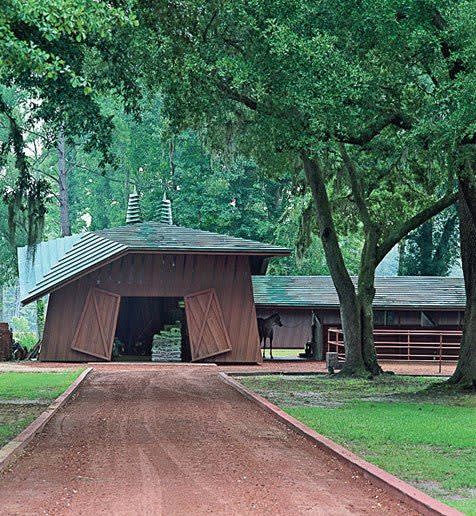
Frank Lloyd Wright
Auldbrass Plantation, 1941
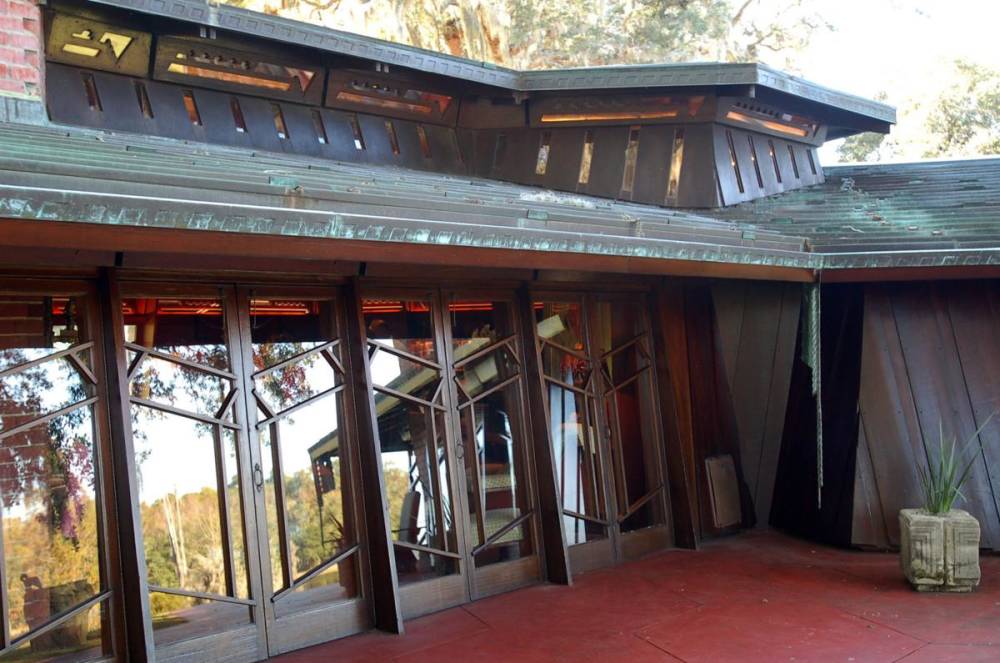
Frank Lloyd Wright
Auldbrass Plantation, 1941
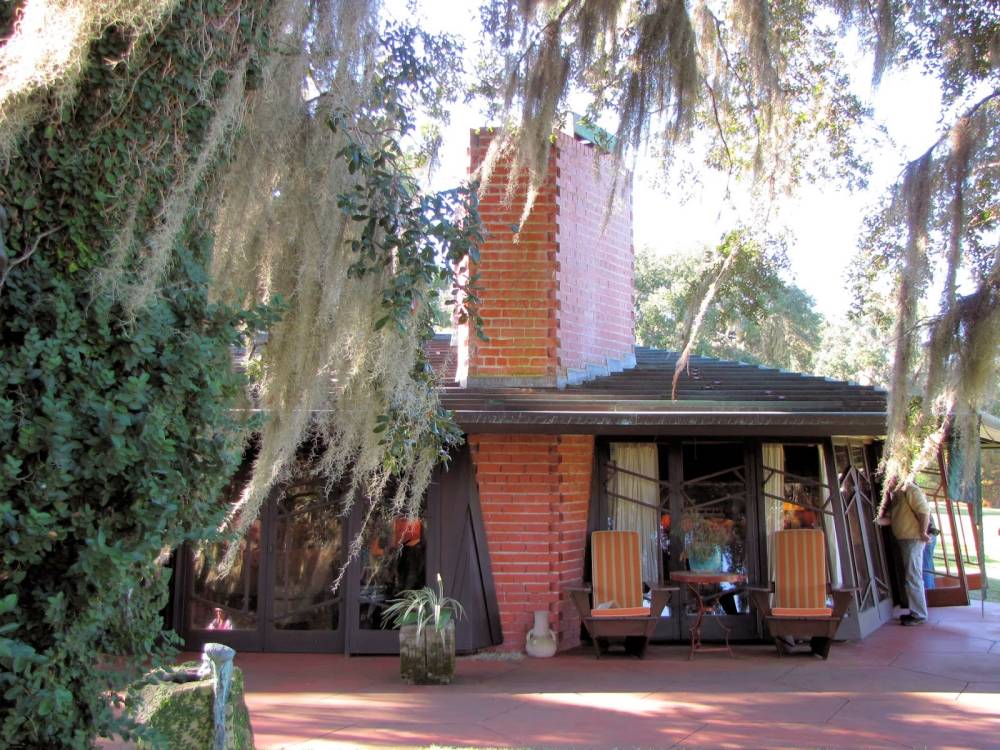
Frank Lloyd Wright
Auldbrass Plantation, 1941
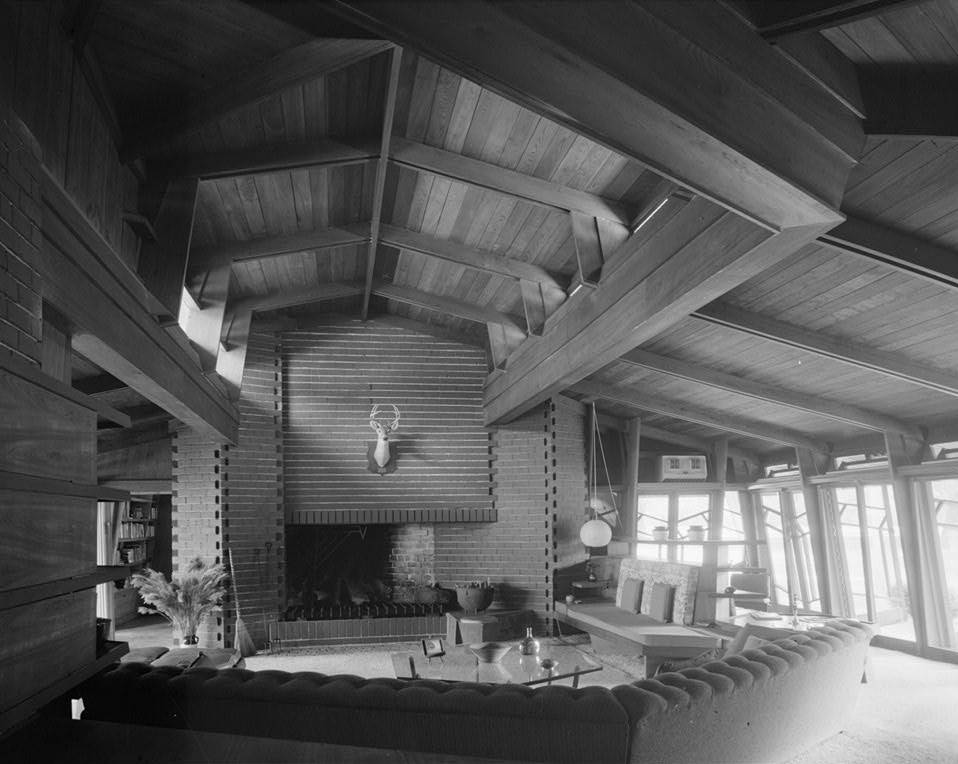
Frank Lloyd Wright
Auldbrass Plantation, 1941
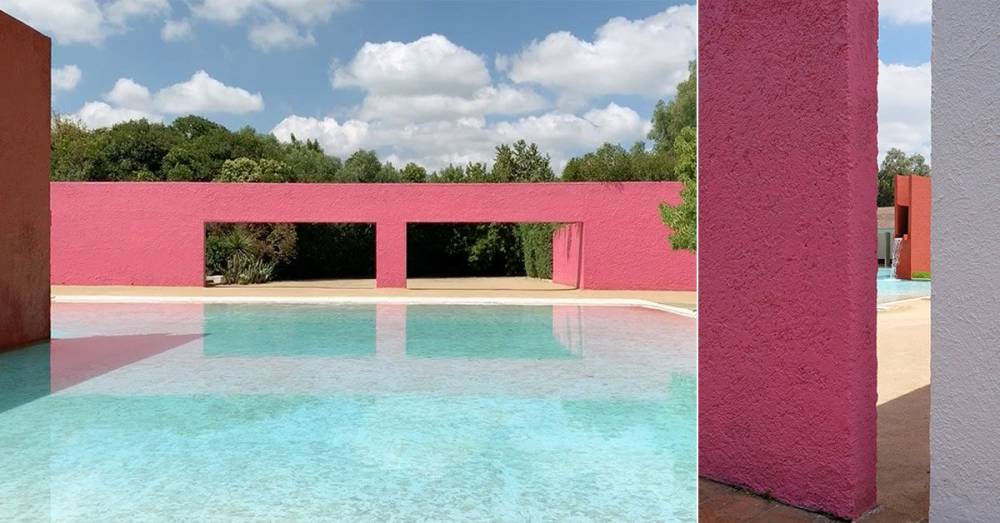
Luis Barragán
Stables at Cuadra San Cristóbal, 1968
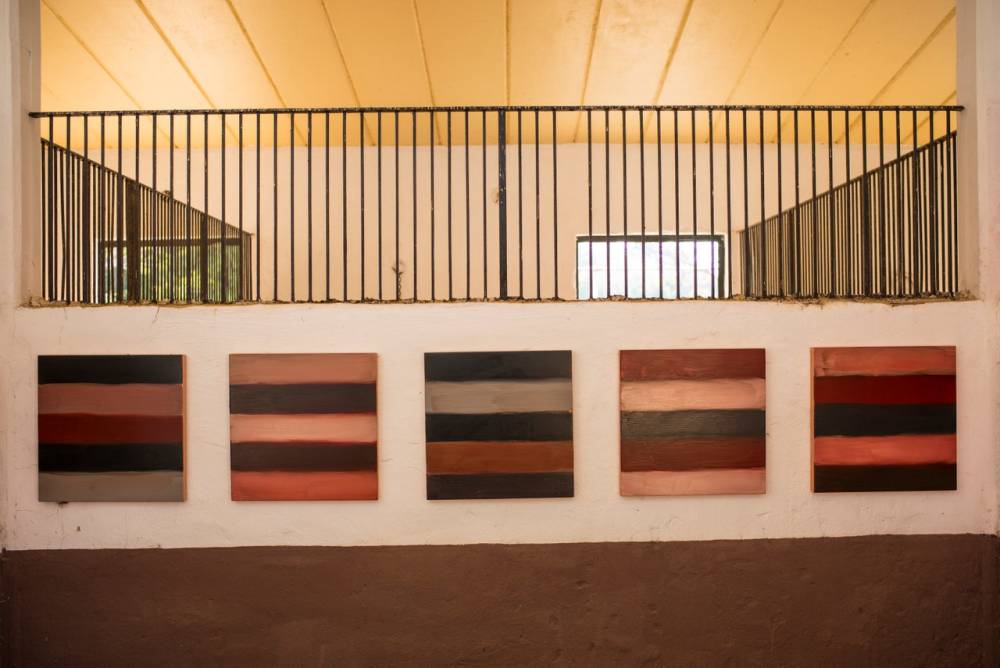
Luis Barragán
Stables at Cuadra San Cristóbal, 1968
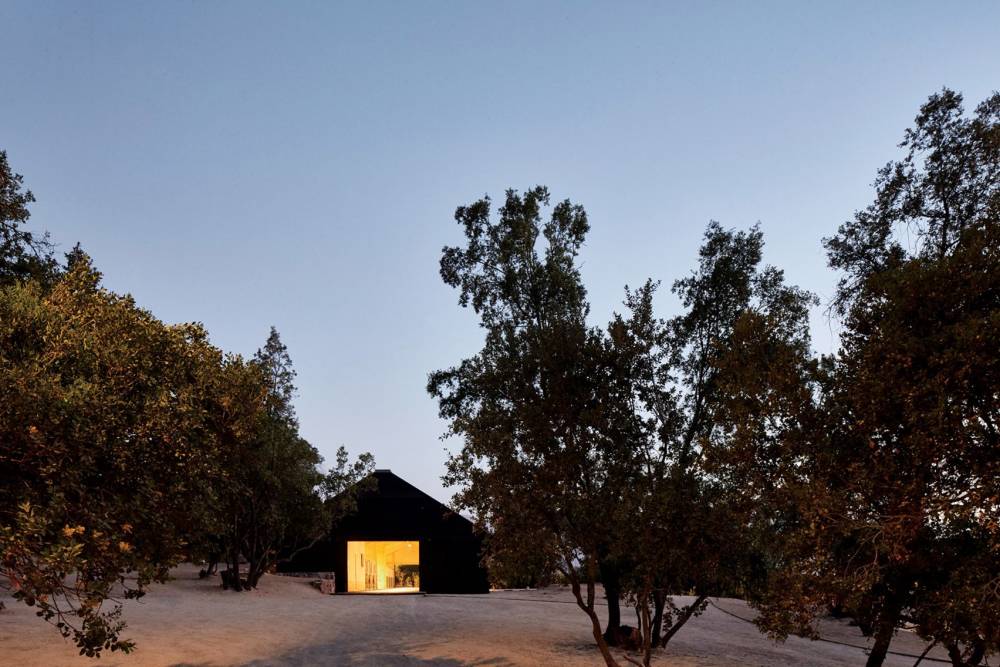
Matias Zegers
Stables, Santiago, Chile
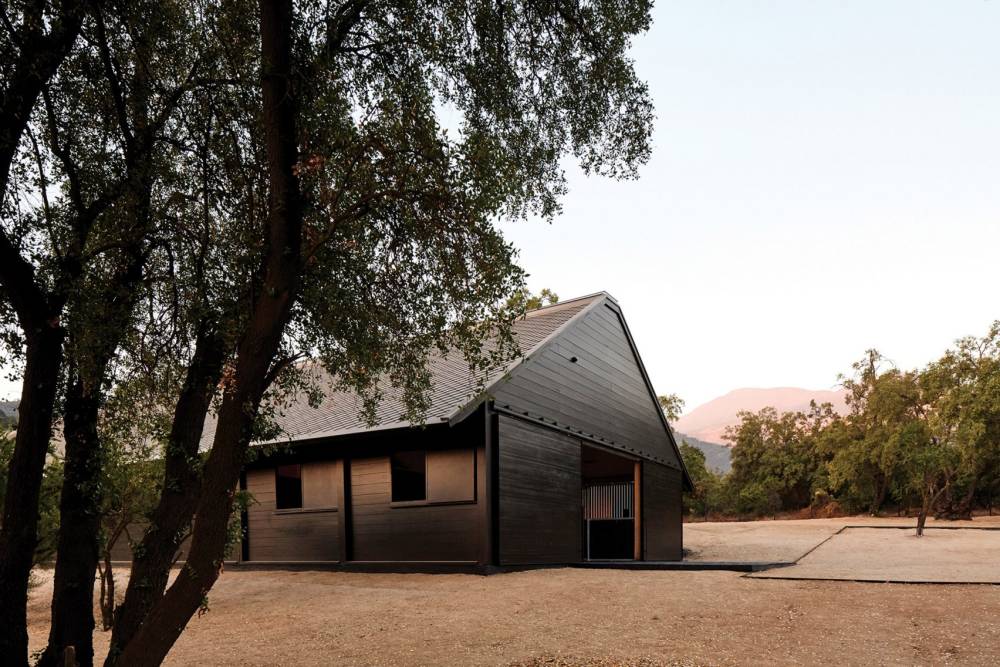
Matias Zegers
Stables, Santiago, Chile
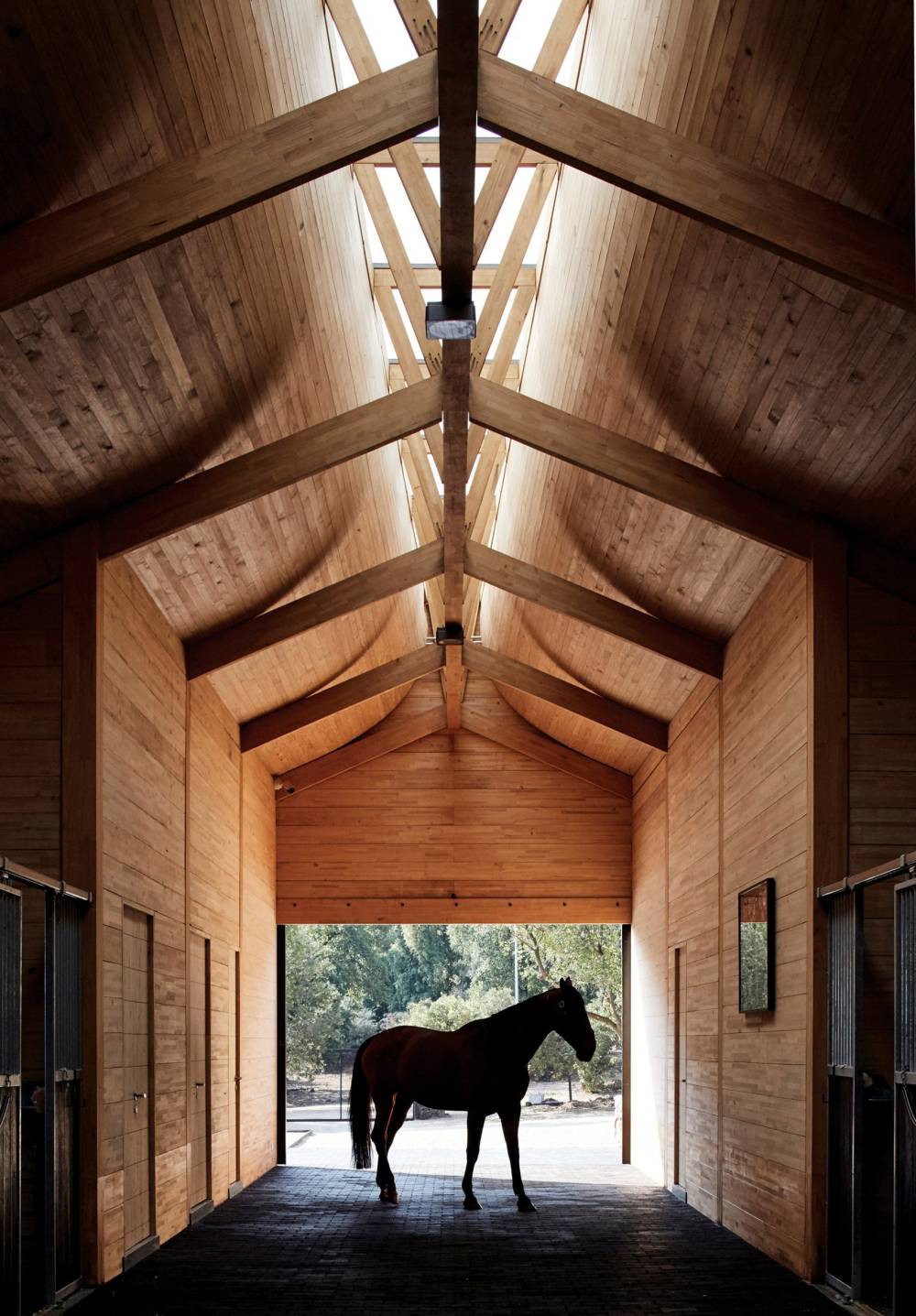
Matias Zegers
Stables, Santiago, Chile
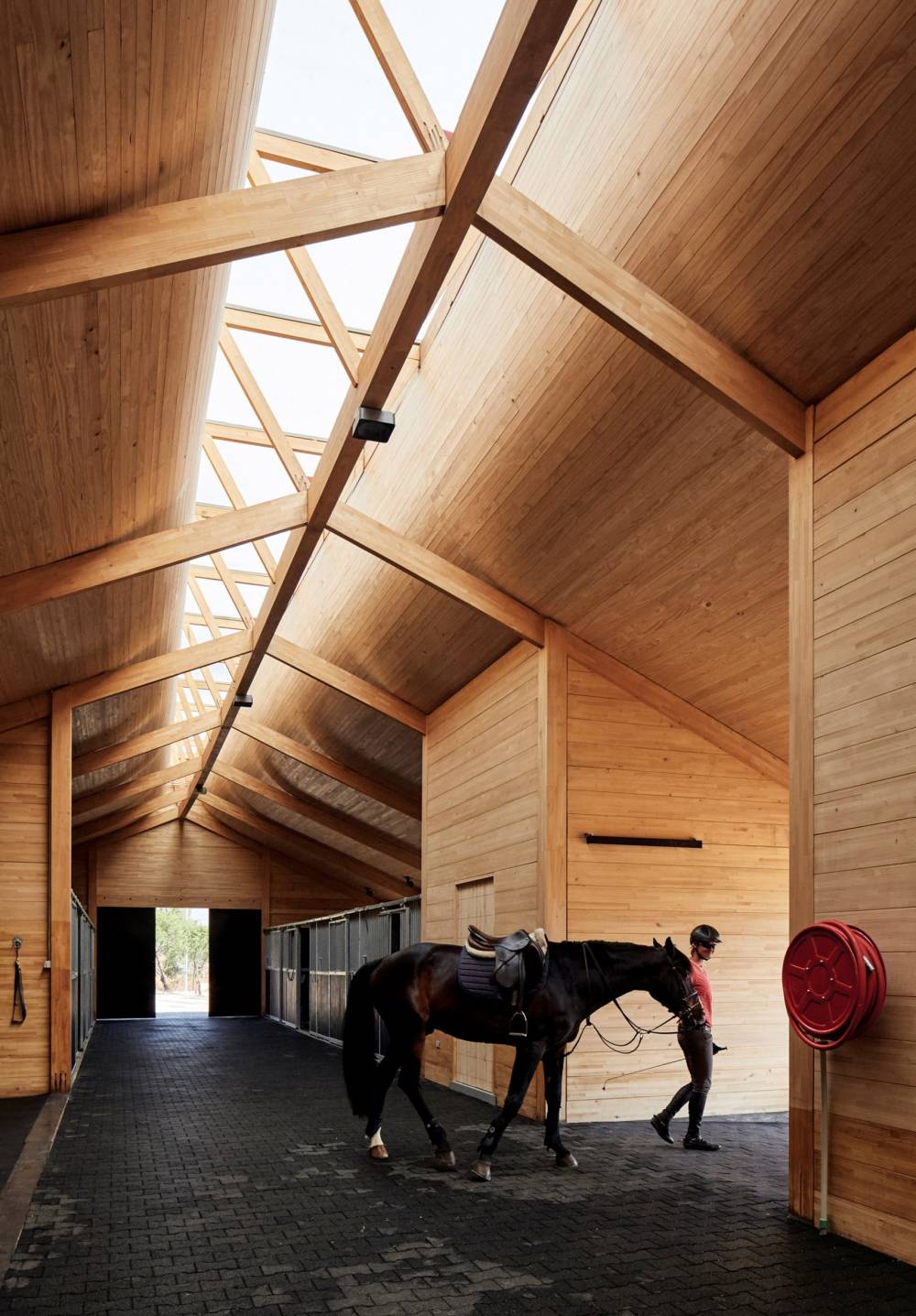
Matias Zegers
Stables, Santiago, Chile
Communal stables by Mexican firm AE Arquitectos, located in Mexico’s state of Jalisco, further attempts to blend man-made architecture with the natural world. Carved from volcanic rock, the ranch’s grey walls and black roof blend in with the country’s mountainous background. Pinewood doors and pillars utilize the plentiful natural resources of the location. A central courtyard features a fountain and oak trees for more natural influence. The contrast between these architectural works, from natural to modern, exemplifies the many visions of architects around the world, even when confronted with such an established design as the stable.
One of the most important design elements necessary for horse riding is the saddle. Designed to support the rider, saddles were a crucial step in the domestication of animals during the Classical Era. Even the ancient statue of Marcus Aurelius features the padding and support of early “saddles”, though it notably does not include the stirrups of the modern saddle.
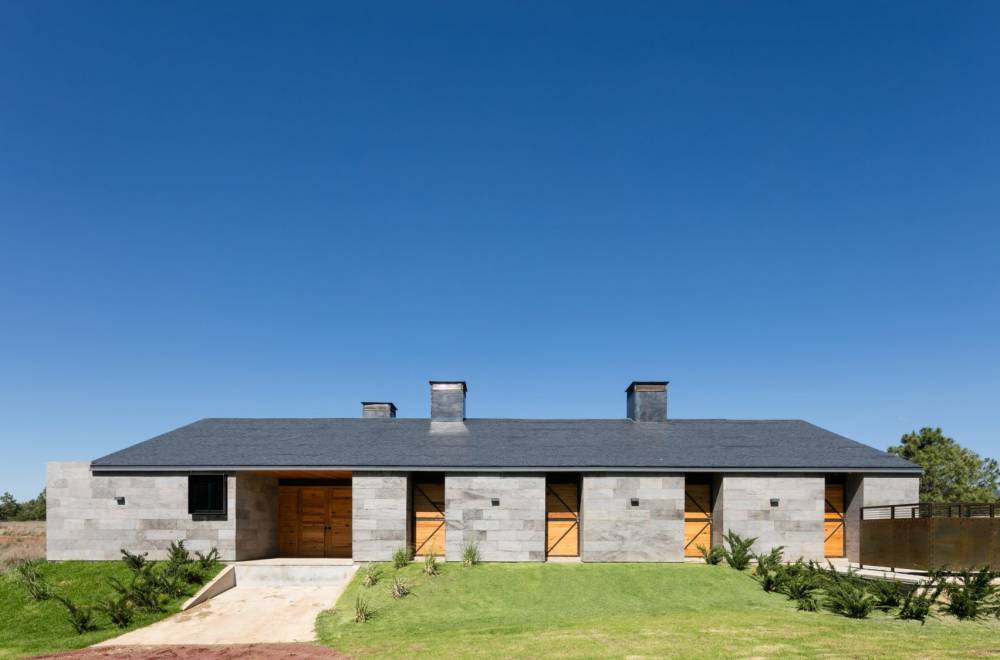
AE Aeqitectos
Gabled Stable, Jalisco, Mexico

AE Aeqitectos
Gabled Stable, Jalisco, Mexico
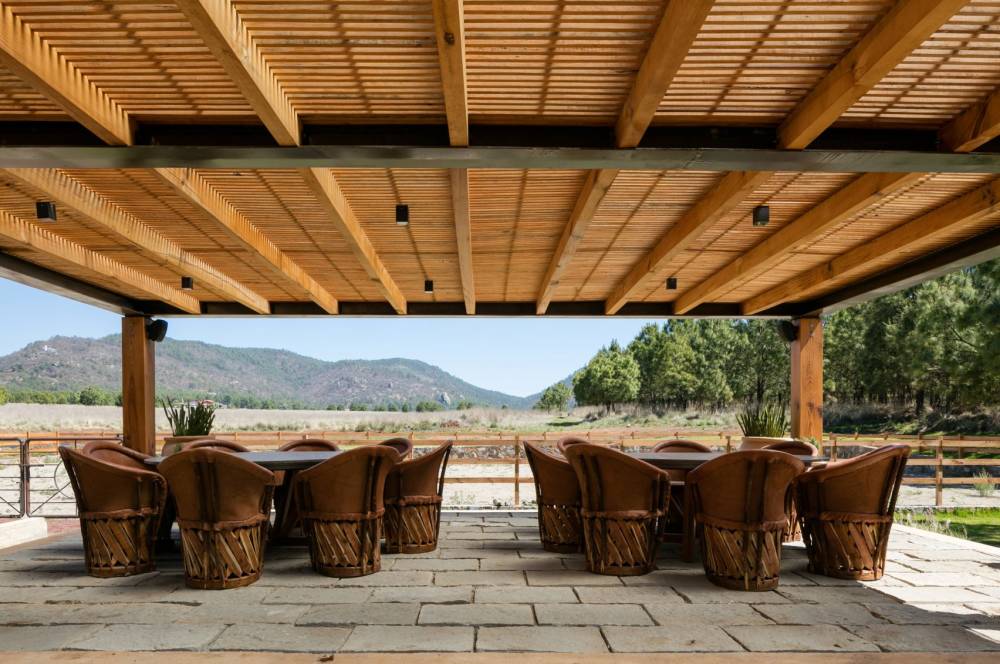
AE Aeqitectos
Gabled Stable, Jalisco, Mexico
It is also important to note that saddles were designed differently around the world depending on the type of native animals available and whether the saddle would be supporting the transport of humans or goods. The English saddle, which encompasses several styles, is generally used for equestrian sports such as polo, dressage, racing, and horse jumping. Western saddles, or “Stock” saddles, are the most recognizable design for those who go on trail rides, watch rodeos, or are familiar with cowboy movies. This type of saddle must be used with a blanket or other form of padding, and is designed with sturdier stirrups for non-professional riders. Military saddles, used by British forces in Britain, Australia, Canada, New Zealand, and South Africa, added a V-shaped arrangement to adjust the girth—the part of the saddle that attaches behind the horse’s front legs. This saddle allows for the girth to be moved to suit the individual horse. Finally, Asian saddles date to the time of the Scythians and Cimmerians as early as 1000 B.C. Central Asian saddles have a prominent horn which comes in handy for stability when playing the traditional sport of Bukashi. East Asian saddles lack padding, like the Western saddle, and must be worn with a saddle blanket. These saddles also have a high pommel and cantle—the front and back raised parts of the saddle—and no horn. Saddles from different cultural regions employ different styles of ornamentation using iron, precious metals, and colorful lacquer. The discrepancies between different types of saddles illustrate different cultures’ beliefs about horses, as well as the different ways the animal is used—be it for sport, travel, or transporting goods.
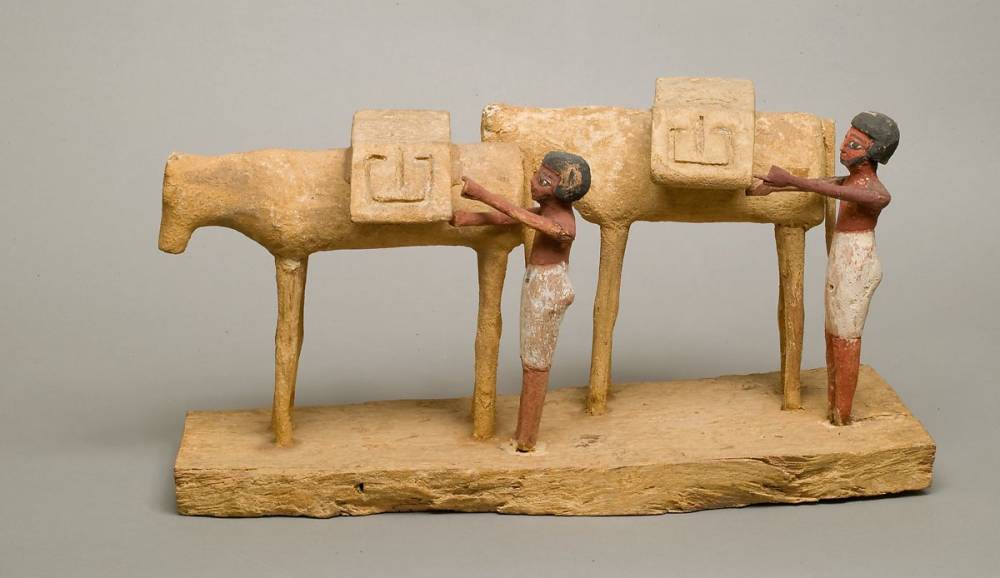
Model of Two Donkeys with Drivers
2030-1850 BC
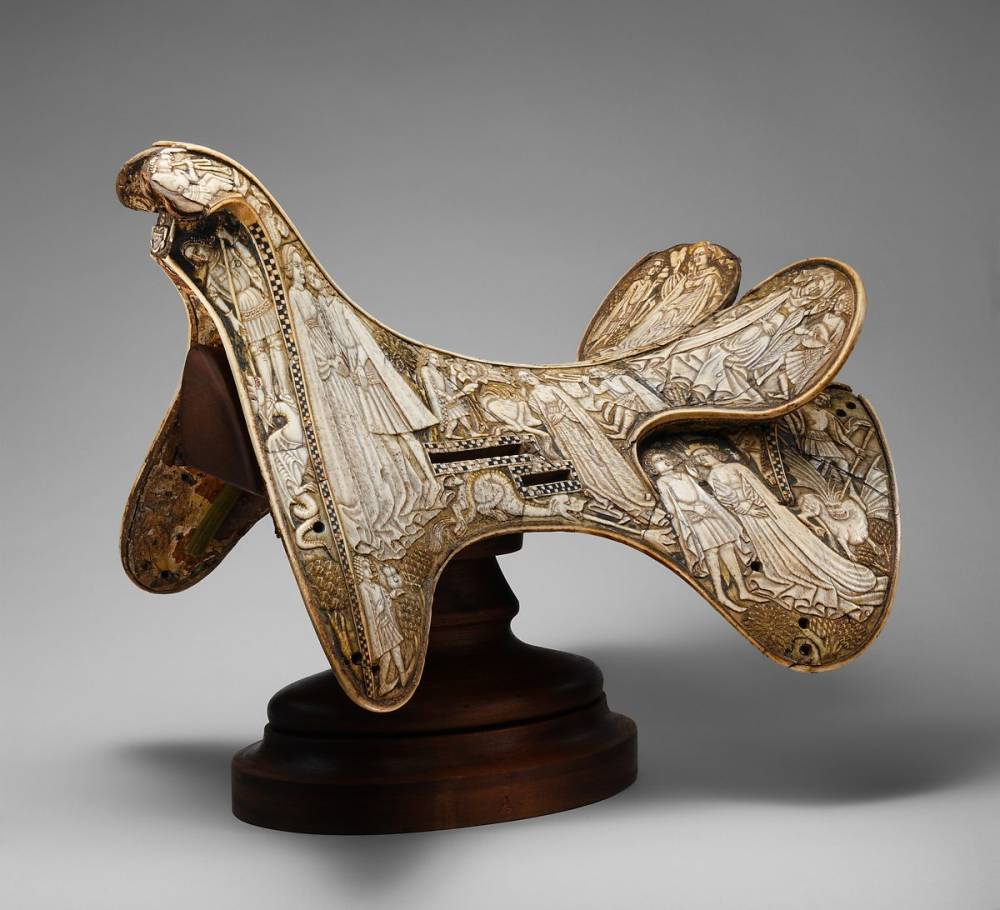
Saddle
Central European, 1400-20
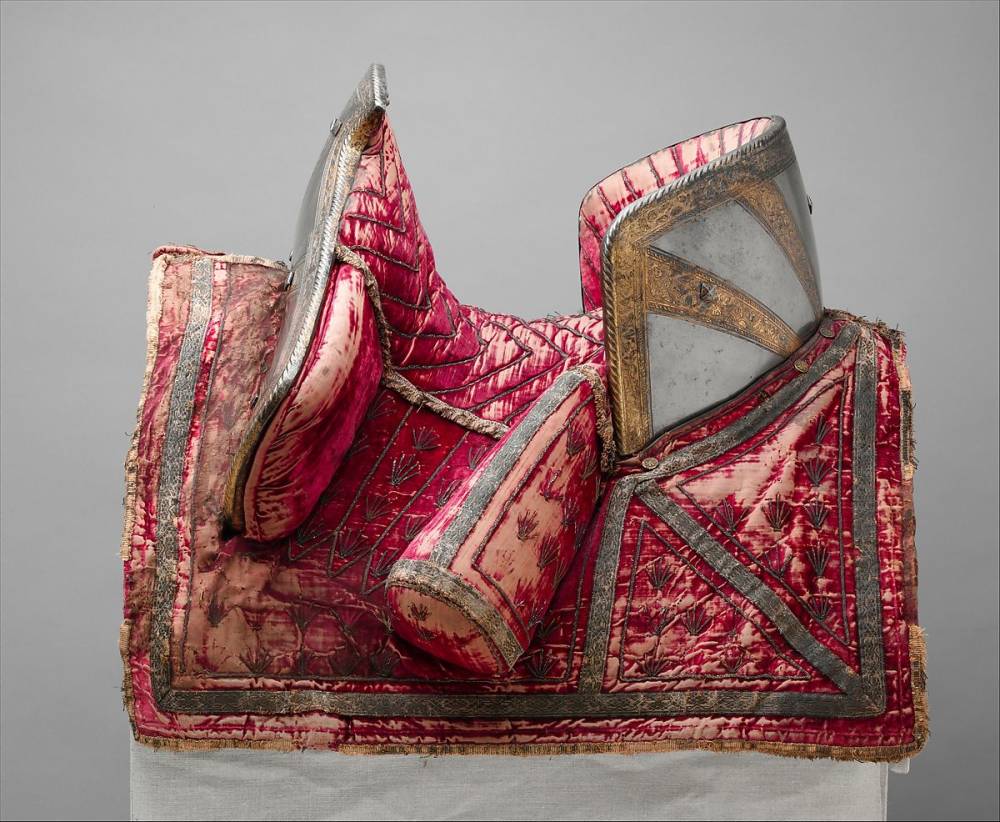
Saddle
Italian, Milanese, 1570-80
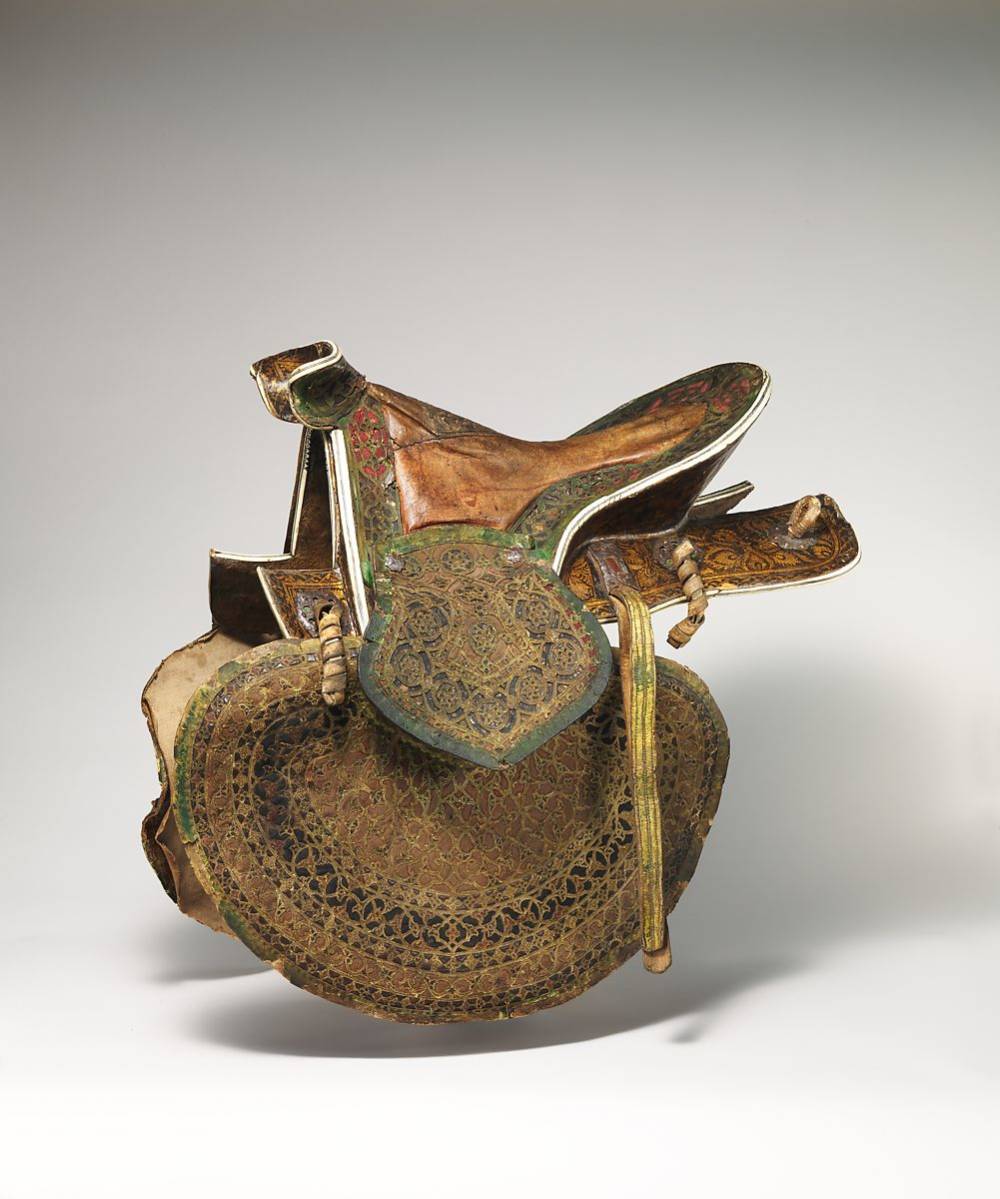
Saddle
Turkish, 16th-17th Century
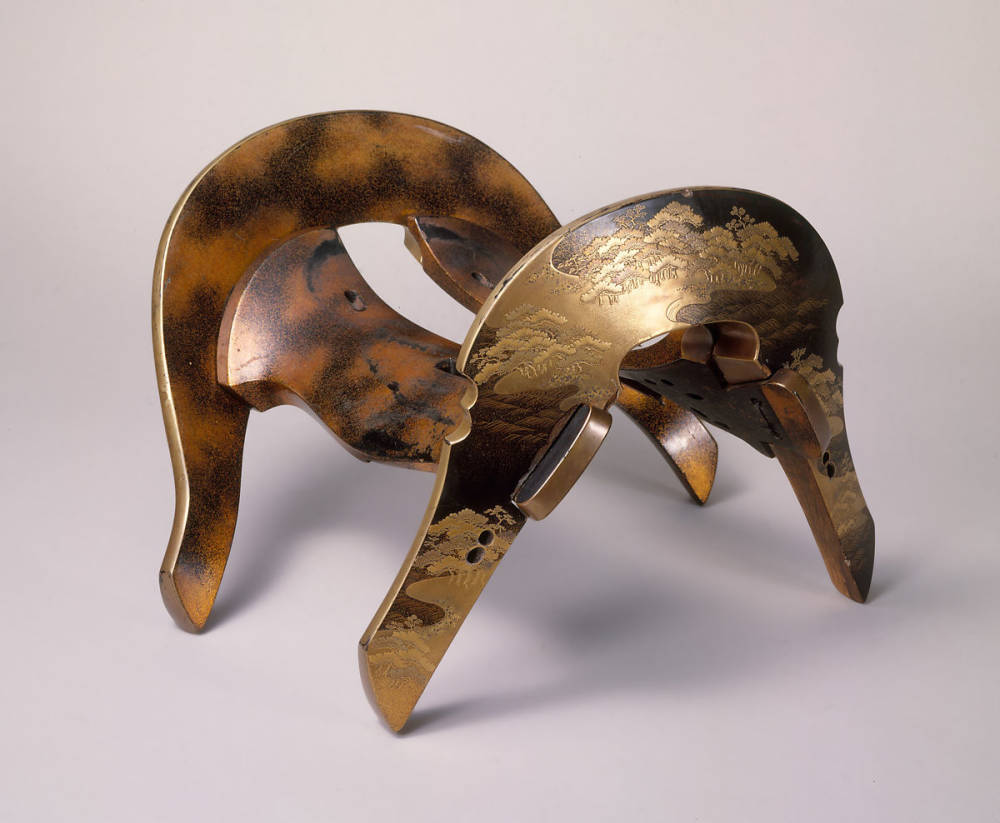
Saddle
Japanese, 17th Century
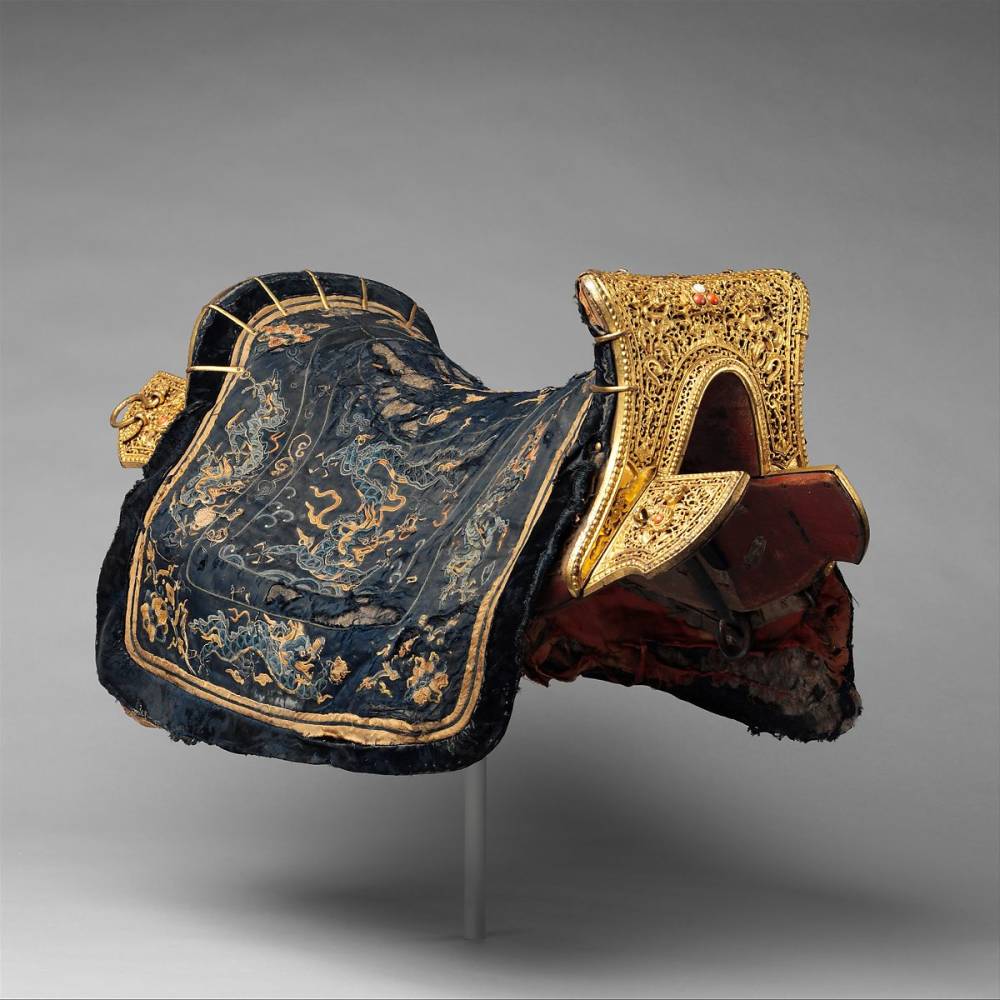
Saddle
Chinese, 17th-18th Century
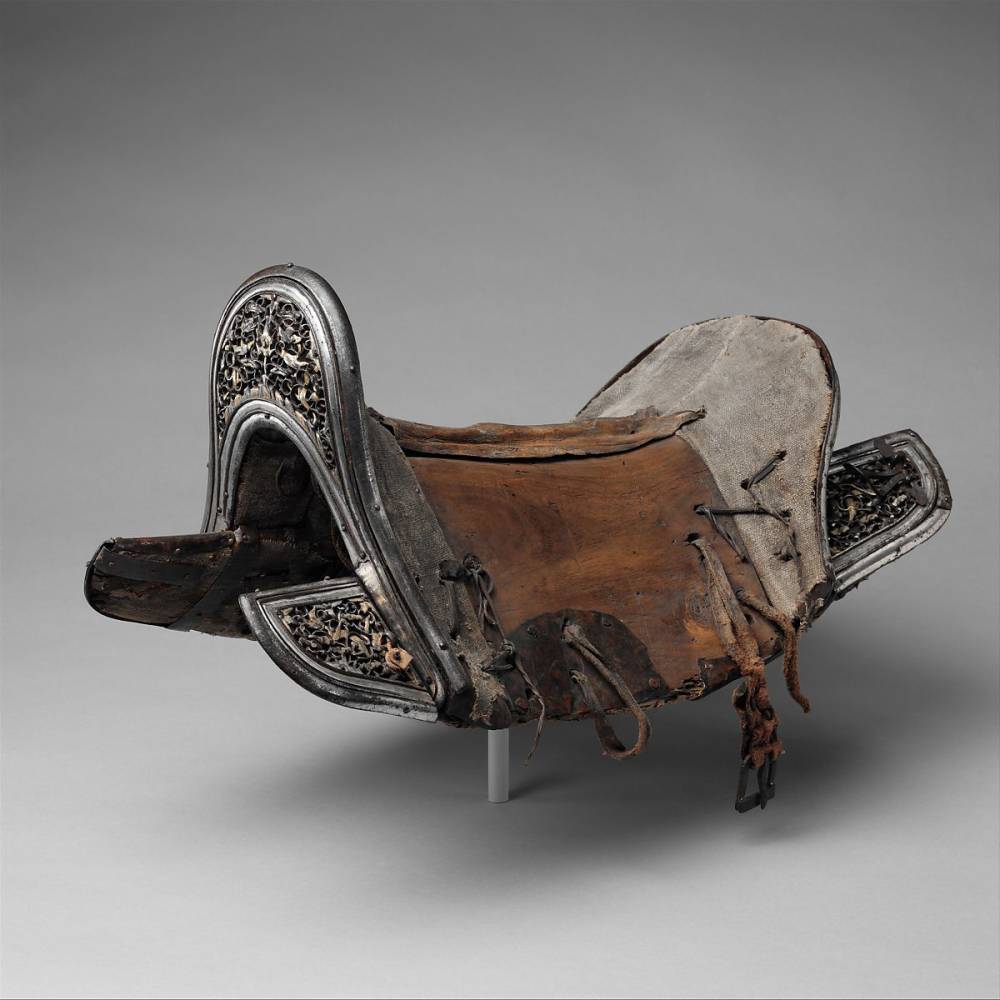
Saddle
Eastern Tibetan or Chinese, 17th-18th Century
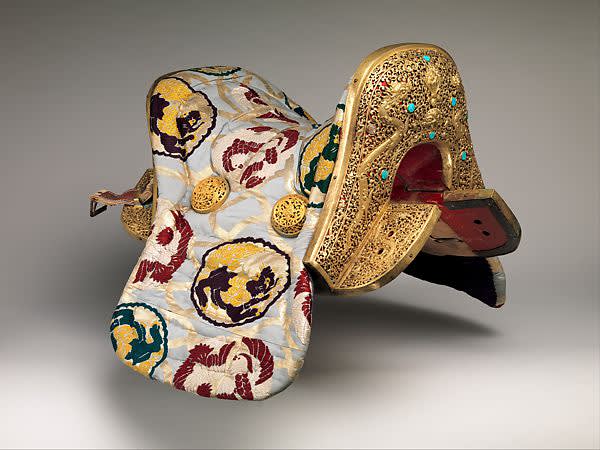
Saddle
Tibetan, 1942-46
The rocking horse, commonly known as a children’s toy today, in fact has a history almost as long as horse riding itself. The tilting seats of the Middle Ages, used for jousting practice, resembles one type of the modern toy. Although the toy did not appear until the 17th century, some manuscripts from the Middle Ages reference carved rocking horses, presumably used as a toy. In the 19th century, the rocking horse became popular as a children’s toy, made by woodcrafters. Some of the toys, especially those made for future monarchs, included highly detailed ornamentation. This fascination with recreating the movement of the horse led to the invention of the carousel in the 19th century. Originally powered by steam, the first carousel was invented by Thomas Bradshaw in 1861 for the Alysham Fair in England. Within a decade, Frederick Savage had invented the now-classic mechanism that allows for carousel horses to go up and down as though they are galloping.
Gustav IIIs Gunghäst
Vintage Rocking Horse
Rocking Horse
England, 1875-1900
Exemplifying the power, history, and symbolism of the horse is the Cavalry 360, a structure created by architecture firm NEON located at Chesters Roman Fort in Northern England. Paying homage to the Roman cavalry that guarded the structure nearly two centuries prior, the circular structure relies on wind power to create a sound landscape that mimics a cavalry of horse’s hooves hitting the ground. The wind rotates turbines, which mimic the motion of the horses’ legs. Visitors are invited to stand in the center of the construction to be transported through sound into the past. This installation acknowledges the rich history of the horse and its connection to culture, war, and the spread of goods and ideas.
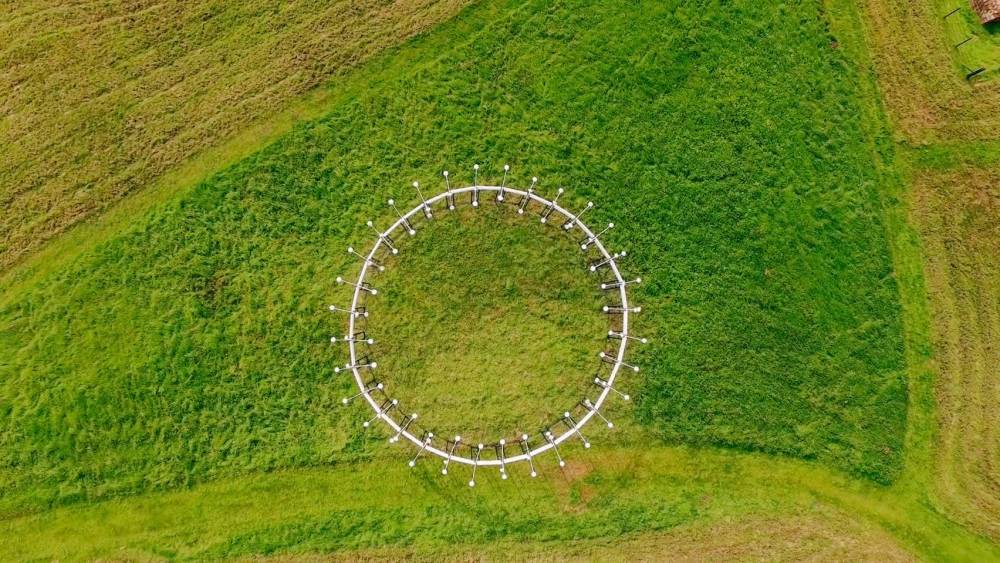
NEON
Wind Turbines
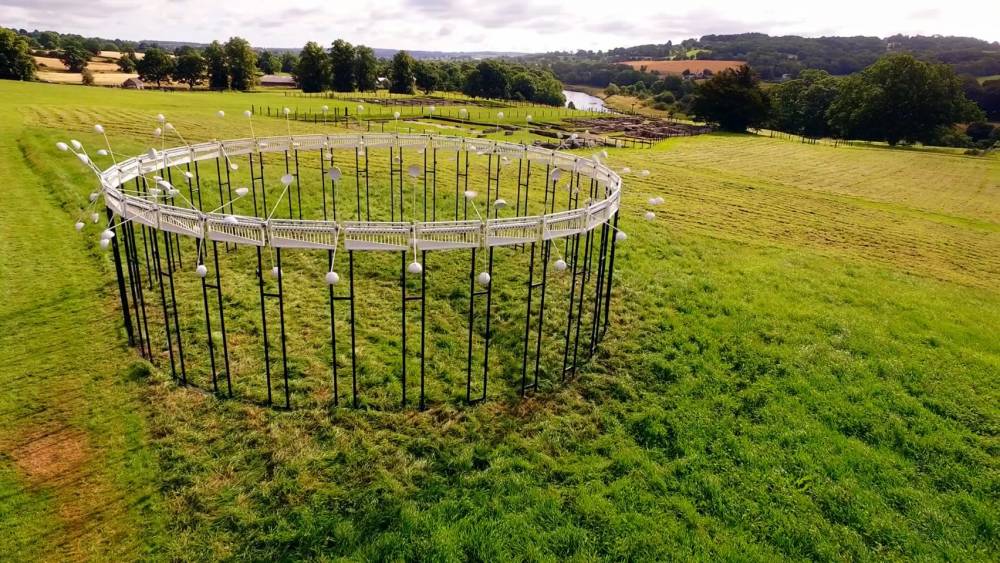
NEON
Wind Turbines
